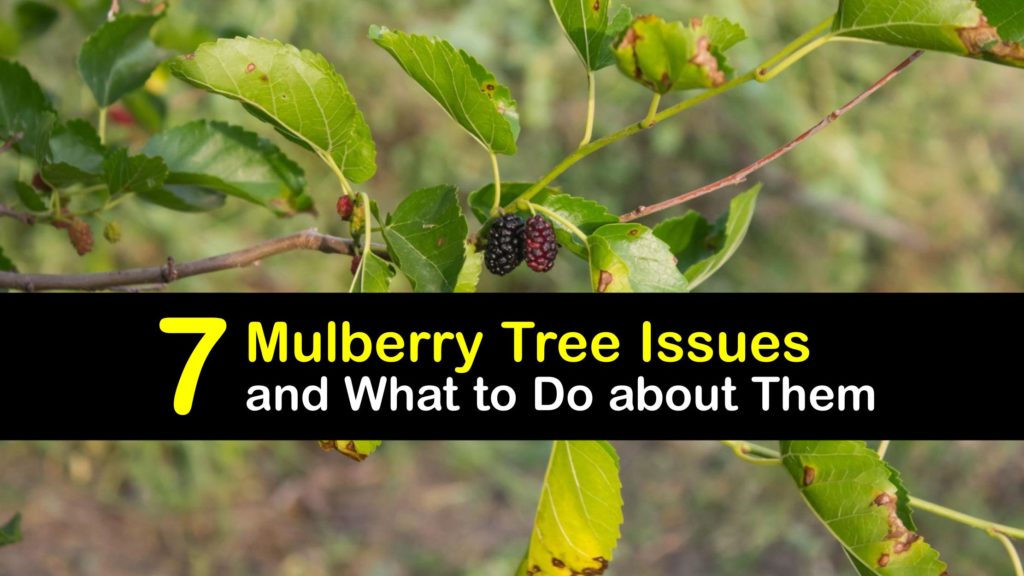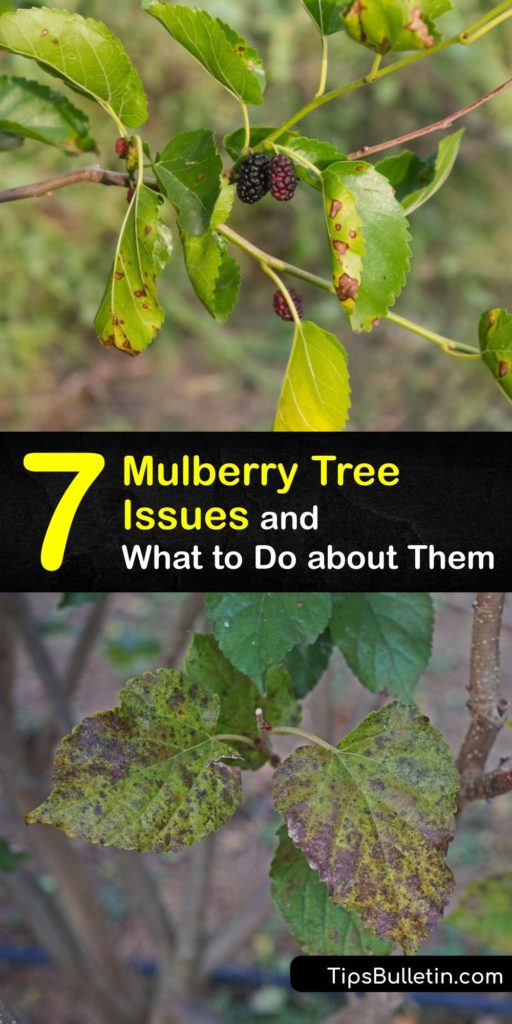Whether you have a white mulberry tree (Morus alba), red mulberry trees (Morus rubra), black mulberry trees (Morus nigra), or a weeping mulberry tree, mulberry tree diseases pose a challenge. Disease and mulberry bugs target mulberry fruit trees and create issues for growers, from fallen leaves to brown spots.
The English brought white mulberries to North America before the American Revolution. Because of the species’ excellent germination and spread efficiency, the population of white mulberry trees has grown. The distinctive native red mulberry tree, on the other hand, is a deciduous tree native to North America but is rarely seen in nature. Mulberry trees, when properly cared for, offer attractive landscape additions.
Mulberries have a black fruit often used for wine or mulberry juice and lobed leaves with medicinal benefits, and many gardeners want to know how to deal with their mulberry problems for an increased harvest.

Addressing Common Mulberry Problems
As an attractive and bountiful tree with berries that look like blackberries, mulberries are relatively easy to grow. However, a shortage in natural resources, improper conditions, a bacterium in the soil, or insect pests create plant disease and may cause affected leaves or impact the branch, bark, or fruit.
If you’re experiencing mulberry tree diseases or mulberry bugs, even after you pick a good time to plant mulberry trees, the first step to addressing your mulberry problems is identifying the culprit.
Becoming familiar with some common mulberry tree (Morus spp) afflictions and their signs and symptoms allows growers to quickly recognize different ailments and treat them promptly for the best outcome.

Mulberry Tree Diseases – Mulberry Leaf Spot
Mulberry leaf spot is a fungal disease causing damage to the tree’s leaves. The initial indications of this disease, which affects fruiting, fruitless mulberry trees and ornamental mulberry trees, are little dark spots appearing in early spring. They gradually grow in size over the growing season.
The dots on infected leaves progressively grow round, with a white dot in the middle resembling a halo with dark brown edges and fruiting bodies developing toward the white centers. When left untreated, trees defoliate. Reduced photosynthesis adds to the stress on the tree; the resulting decline takes several years. Treat mulberry leaf spot with fungicides.
Mulberry Bugs to Avoid
Mulberry trees are susceptible to a range of pest insects. Though the trees are hardy, it’s still important to be aware of a pest infestation.
Fortunately, these bugs won’t damage older trees since they’re sturdy enough to handle them, which is helpful because treating a 50-foot tree is no simple process. Use a horticultural oil like neem oil if you discover signs of an infection on a more fragile young sapling.
Recognize Sooty Canker
Sooty canker is one of numerous mulberry tree diseases. It affects the bark and is primarily noted on the branches, though it might infect the trunk.
Sooty canker is a fungal ailment caused by the fungus Hendersonula toruloides. The only way to combat this tree infection is to catch it early. To get rid of white stuff on tree branches, prune infected branches using sharp, sterile pruning tools as soon as wilt and cankers emerge.
To avoid reinfection, apply a fungicide to the wound. Discard limbs in the trash as composting, chipping, or burning them transmits the fungus to neighboring trees.
Powdery Mildew on Mulberry Trees
Powdery mildew is a common fungus in the garden, and it spreads rapidly. You’re probably dealing with powdery mildew if your mulberry tree’s leaves, buds, and twigs develop a whitish-gray powdery mold.
This illness causes the leaves fold and curl upward, and new shoots may grow slowly. Collect and destroy fallen leaves, and spray diseased foliage with a powdery mildew-specific fungicide to remove this fungus from your tree.
Mulberry Trees are Susceptible to Cotton Root Rot
Phymatotrichum root rot, Ozonium root rot, and Texas root rot are names for the same disease, often called Cotton Root Rot. It causes mulberry leaves to wilt and turn yellow or bronze. The illness leads the tree’s roots to rot, yet the wilted leaves stay attached.
Unlike other common mulberry issues, Cotton Root Rot causes mulberry trees to die suddenly, sometimes in just a couple of weeks. When Cotton Root Rot manifests itself, it has progressed throughout your tree’s entire root system.
There is no cure, and you must eradicate the tree to prevent the disease from spreading. It also survives in the soil, so wait at least five years before planting sensitive plants there. The most vulnerable species to Cotton Root Rot are white mulberry trees.
Armillaria Root on Mulberries
Armillaria Root Rot is a fungus targeting mulberry trees that causes discolored leaves to drop prematurely from the tree. This disease may kill branches or the entire tree if it is not addressed in time.
If your mulberry tree has an infected branch, prune it from the tree immediately and dispose of it away from the garden to avoid reintroducing the fungus. When armillaria root rot has spread to the entire tree, it must be dug up and removed. Fungicides and other chemical control methods typically do not help.
Managing armillaria root rot is challenging, so it’s best to plant disease-resistant healthy tree stock. If you know this disease was recently present in your garden, don’t plant anything susceptible to avoid reinfection.
Popcorn Disease Causes Misshapen Fruits
One of the oddest mulberry tree illnesses is Popcorn disease. Mulberry fruits grow wide and elongated, giving them a popcorn-like look and making harvesting difficult. Only trees growing in the southern states are affected by this unusual disease.
Ensure any diseased fruits, including all fallen berries and debris, are collected and discarded. Because Popcorn sickness spreads quickly, make every effort to prevent it by removing infected items and disposing them in the trash, not the compost pile. Fortunately, most trees are not destroyed by Popcorn disease, though their fruits appear unattractive .
Avoiding Mulberry Pests and Diseases
Every mulberry bush or tree can be harmed by disease or insects. Factors such as planting location and local weather play a role in the types of problems each tree experiences. Disease-resistant trees are the best choice if available. Growing disease-resistant varieties dramatically cuts down the incidences of illness and infection.
Most insects and illnesses are kept at bay with good tree care. Follow the planting guide when adding a tree to your space. Keep up with regular watering, fertilizing, trimming, spraying, weeding, and fall cleanup. Trash or burn diseased plant matter, branches, and other debris well away from your garden to avoid spreading bacteria and fungus.
Though beautiful and productive, it’s worth knowing mulberries are the cause of issues for those suffering from allergies. Many cities, beginning with El Paso in 1992, banned the planting of new mulberry trees for the sake of improving public health.
Check your local regulations before adding this fruit tree to your garden. If you’re facing mulberry bugs or diseases, early diagnosis and swift treatment should help prevent progression and save your harvest.

If you loved this article on mulberry tree diseases, please share this thoughtful advice for mulberry problems with your friends and family on Pinterest and Facebook.